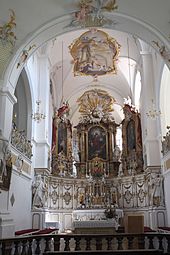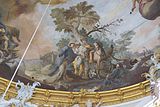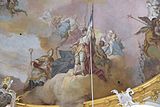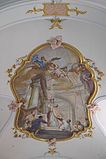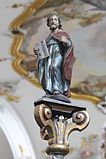St. Alto and St. Birgitta (Altomünster)
The Catholic parish and former monastery church Sankt Alto and Sankt Birgitta in Altomünster , a market town in the Dachau district in Bavaria , was built in the second half of the 18th century on the site of a Romanesque predecessor building from the 13th century. The church is dedicated to St. Alto , a hermit who, according to legend, founded a monastery in Altomünster around 760, and St. Birgitta of Sweden , the founder of the Order of the Redeemer . The church is one of the last large sacred buildings of the Rococo , the ceiling frescoes by Joseph Mages (1728–1769) and the stucco decoration by Jakob Rauch are already at the transition to classicism . Most of the altarpieces were also made by Joseph Mages, the altars and the carved figures are largely by Johann Baptist Straub (1704–1784). The parish has been looked after by priests of the Teutonic Order for many years .
history
The Altomünster monastery was settled in the second half of the 10th century by Benedictines and from 1056 by canons . Benedictine nuns lived there from 1278 at the latest . In 1244 a three-aisled basilica with probably three apses and a west tower was consecrated. Today's entrance area of the church goes back to this building. There are no remains of earlier church buildings.
In 1485 the Benedictine monastery was closed "because of mismanagement" and in 1497 it was re-assigned as a double monastery of the Order of the Redeemer. In connection with the takeover of the monastery by the Order of St. Birgit, the choir was probably rebuilt and the monks' choir built as early as 1488 . Between 1613 and 1619 the interior was redesigned in the early Baroque style.
Between 1763 and 1773 the dilapidated church was rebuilt by Johann Michael Fischer . After his death in 1766, his foreman Balthasar Trischberger completed the building of the church.
In the course of secularization , the monastery was closed in 1803 and used as the Birgitten nunnery from 1841 until it was closed by the Vatican in 2015 , in which only the prioress lived.
architecture
Exterior construction
The 62-meter-high, two-storey bell tower rises high above the town above the still Romanesque substructure of the west facade. It is framed by corner pilasters and covered by a tiered onion hood crowned with a lantern . A steep ramp staircase leads to the main portal in the tower facade, which is structured by pilasters and closed at the top by a segmented gable and lateral volutes . In a niche at a height of 15 meters is the 3.5 meter high, gold-plated figure of St. Alto, who is represented with his attributes , the abbot, a knife and a chalice with the baby Jesus. The central building, reinforced with buttresses, is joined to the east by the strongly drawn-in, three-sided closed choir .
inner space
The Church as hall structure applied with an octagonal main space defined by a 18-meter high slopes dome is surmounted. Caryatids in angelic form seem to support the dome. Open large arches, the two-story galleries to the main space surrounded by pillars with stucco capitals and cranked beams is divided. The galleries have artistically carved grids in white and gold.
To the east of the main room is the smaller, so-called confessional room. It is square with bevelled corners and is covered by a flat dome. The confessional room, above which the nuns' choir is located, opens to the east to the choir, which is covered by a barrel cap . It consists of the lay choir and the monk's choir, which is slightly higher due to the hillside location. Like the nuns' choir, this was reserved exclusively for members of the order.
Ceiling frescoes
The ceiling frescoes were made by the painter Joseph Mages , who comes from Tyrol and lives in Augsburg . They are signed with the year 1767.
Ceiling fresco in the main room
The Trinity is depicted in the center of the dome fresco of the main room . Jesus , dressed in a red robe, holds the cross, God the Father is wrapped in a golden robe, over both of them the Holy Spirit hovers in the form of a dove. On the middle level a crowd of saints is enthroned on clouds. On the left, the holy Alto, marked by the abbot's staff, next to it the monk Richard Reynolds (around 1492–1535), whom the English King Henry VIII had executed because he did not recognize him as head of the Church in England . He holds a palm frond in his hand as a sign of his martyrdom. On the right side, Mary takes St. Birgitta and other women religious under her protective cloak. Above you can see martyrs like St. Agnes of Rome , under whom a lamb can be seen, and St. Barbara of Nicomedia , who is represented with her attributes tower, chalice and host .
The history of the monastery is reminded on the edges of the dome fresco. According to legend, the Frankish King Pippin the Younger , the son of Karl Martell and father of Charlemagne , gave the holy Alto Land so that the latter should found a monastery there. It is said to have been founded around 730, but there is no evidence.
An important episode in the history of Altomünster was the founding of a double monastery in 1497. For this purpose, Birgitten from the Maihingen monastery received the dissolved Benedictine monastery from the Bavarian Duke Georg the Rich and his wife Jadwiga through the mediation of Count Wolfgang von Sandizell as a gift. A scene on the dome fresco shows the presentation of the deed of donation by Duke Georg. The nuns are shown in their gray robes with black veils and the white Birgittens crown. They stand above the monks, who act like supplicants and to whom the nuns give orders. The Birgitten monasteries were designed as double monasteries and the monks were obliged to obey the abbess.
Another scene shows how the founder of the order, Birgitta, received confirmation of her rule from Pope Urban V in 1370 .
In another scene a group of saints is gathered. On the far left is St. Augustine , dressed as a bishop, with the crosier and a burning heart. Next to it, Saint Leonhard crouches on a cloud with a chain in his hand. In the foreground stands St. Florian , who is dressed as a soldier and holds a flag in his hand. Saint Wendelin can be recognized by his shepherd's clothing. In the background you can see the martyrs Crispinus and Crispinianus , the patron saints of the shoemakers, with their attribute, the shoemaker's hammer.
Ceiling fresco of the confessional room
The ceiling fresco in the confessional room depicts the healing of the paralyzed man from Bethesda on one half and the discovery of the spring on the other half, where, according to legend, St. Alto founded his monastery.
Frescoes in the chancel
The two ceiling frescoes in the sanctuary represent the east, the vision of Saint Alto and to the west the vision of John of Patmos, the author of revelation ,. The holy Alto stands at the altar and celebrated the Mass, he holds the cup for conversion high, from whom the baby Jesus rises. An angel shows John his gaze upwards, where the heavenly Jerusalem with its twelve gates appears to him. The three smaller grisaille pictures on the walls in stucco frames are dedicated to the veneration of Mary.
Piece
The stucco decorations from the period 1766 to 1768 is derived from the active also in Augsburg and Wessobrunner school scoring smoke Jacob . Flower garlands and rocaille cartouches in white and gold are carefully distributed in the room and do not appear overloaded. The angel putti on the entablature and the caryatids under the dome are painted pink. The stucco capitals of the pilasters are decorated with the heads of angels and the cross of the Birgit order.
organ
The organ dates back to 1803 demolished convent of the Order of Augustinian Recollects in taxa , a district of Odelzhausen in the district of Dachau. The organ case dates from around 1760. The instrumental part was built in 1986 by the organ building company Sandtner with 25 stops and three manuals using historical inventory from around 1760, 1883 and 1919. The disposition is:
|
|
|
||||||||||||||||||||||||||||||||||||||||||||||||||||||||||||||||||||||||||||||||||||||||||
- The 1st manual is a coupling manual .
- Coupling : II / P, III / P, Organo-plenum
- Comments: sliding drawer , mechanical play and stop action.
Bells
There are six ringable bells hanging in the tower:
- Bell 1, St. Alto, 2600 kg, consecration 1950, nominal strike note b 0 , diameter 165 cm, Czudnochowsky, Erding; Chime
- Bell 2, Christ the King, 1300 kg, 1950, d 1 , 135 cm, Czudnochowsky, Erding; Quarter-hour strike
- Bell 3, St. Maria, 900 kg, 1950, f 1 , 115 cm, Czudnochowsky, Erding
- Bell 4, St. Josef, 600 kg, 1990, g 1 , 103 cm, Perner, Passau
- Bell 5, St. Michael (death bell), 300 kg, 1949, c 2 , 76 cm, Czudnochowsky, Erding
- . without No, St. Birgitta (Weather bell), 350 kg, 1949, a. 1 , 95 cm, Czudnochowsky, Erding; the only bell not electrically operated, operated by hand with a rope
Carillon
Since December 11, 2005 there is a carillon with 24 bells (largest bell 200 kg) in the tower (not visible from the outside). The bells cannot vibrate and are struck from the inside with a hammer. The range covers a good two octaves from d 2 to d flat 4 . The casting was carried out by the Perner company in Passau. The carillon can be played by hand using a keyboard, e.g. B. for organ tours. Songs that are programmed in advance are played automatically three times a day to match the church year. The carillon can be heard from Monday to Saturday at 9 a.m., 1 p.m. and 5 p.m. and on Sunday at 1, 3 p.m. and 5 p.m.
Furnishing
- The pews date from the time it was built and have artfully carved rocaille cheeks. During the restoration, the original baroque color scheme was restored.
- The communion bench between the confessional room and the choir has also been preserved from the time it was built . It was made in 1770 by the Dachau sculptor Franz de Paula Arnoldt (1724–1788) from oak.
- Angel sputtles with symbols of the evangelists sit on the basket of the carved wood pulpit . The volutes of the sound cover are also set with putti, one blows the trumpet.
- The semicircular tabernacle altar replaces an earlier one by Johann Baptist Straub and was recreated at the end of the 19th century. The neo-baroque wooden wall separates the church from the monks' choir, which is accessible to laypeople. Only the two figures of the apostles John and James the Elder still come from the original altar.
- The figures of the other apostles were also carved by Johann Baptist Straub around 1770. They are painted in polished white and stand as assistant figures at the altars.
- Several 18th century sacrificial boxes have been preserved in the church.
- Most of the procession poles date from the 18th century. The figures represent St. Florian, St. Joseph , a bishop, a monk, a saint and Moses with the tablets of the Law.
Epitaphs
In the anteroom, next to the entrance, epitaphs are placed on the walls , u. a. two red marble epitaphs for Christina von Machslrain († 1535) and Barbara von Adelzhausen († 1536).
literature
- Wolf Bachbauer: Altomünster. Parish and monastery church St. Alto and St. Birgitta . Kunstverlag Josef Fink , Lindenberg 2006, ISBN 3-89870-280-4 .
- Georg Dehio : Handbook of German Art Monuments - Bavaria IV - Munich and Upper Bavaria . 2nd Edition. Deutscher Kunstverlag, Munich 2002, ISBN 3-422-03010-7 , p. 32-36 .
- Klaus Peter Zeyer: The bells of the parish and monastery church St. Alto in Altomünster . Amperland 51 (2015) 455.
- * Wilhelm Liebhart : Altomünster, monastery, market and community. Altomünster 1999
Web links
- St. Alto and St. Birgitta monastery church in Altomünster kirchenundkapellen.de (accessed on July 8, 2016)
- Altomünster House of Bavarian History (accessed July 8, 2016)
Individual evidence
- ↑ http://www.deutscher-orden.de/ Einsatzorte/ altomuenster.php
- ↑ St. Alto and St. Birgitta monastery church in Altomünster. History of the monastery kirchenundkapellen.de (accessed on July 8, 2016)
- ↑ Vatican solves Birgittenkloster on sueddeutsche.de from December 3, 2015 (accessed on July 8, 2016)
- ↑ Bavarian organ database online
Coordinates: 48 ° 23 ′ 19 ″ N , 11 ° 15 ′ 23.4 ″ E




